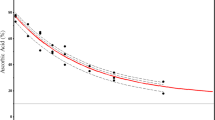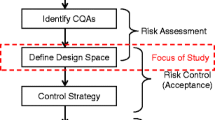Abstract
A quantitative, model-based risk assessment process was evaluated using Bayesian parameter estimation to determine the posterior distribution of the probability of a model tablet formulation’s (gabapentin) ability to meet end-of-expiry stability criteria-based manufacturing controls. Experimental data was obtained from an FDA-supported, multi-year project that involved researchers at nine universities working collaboratively with industrial and governmental scientists under the leadership of the National Institute for Pharmaceutical Technology and Education (NITPE). The risk assessment process involved the development of a design space manufacturing model and shelf life stability model that shared stability-related critical quality attributes (CQAs). Monte Carlo simulations of the design space and shelf life models that uses model parameter uncertainty to estimate the probability of shelf life failure as a function of manufacturing control. The resultant linked design space and shelf life stability models were tested by comparing model predicted and observed long-term stability data generated under a variety of pilot scale production conditions.




Similar content being viewed by others
References
US-FDA Guidance for Industry. Q9 quality risk management. U.S. Department of Human Services, Food and Drug Administration (CDER and CBER); 2006.
Cogdill RP, Drennen JK. Risk-based Quality by Design (QbD): a Taguchi perspective on the assessment of product quality, and the quantitative linkage of drug product parameters and clinical performance. J Pharm Innov. 2008;3:23–9.
Short SM, Cogdill RP, D’Amico F, Drennen JK III, Anderson CA. A new definition of pharmaceutical quality: assembly of a risk simulation platform to investigate the impact of manufacturing product variability on clinical performance. J Pharm Sci. 2010;99(12):5046–59.
Zong Z, Desai S, Barich A, Huang H-S, Munson E, Suryanarayanan R, et al. The stabilizing effect of moisture on the solid-state degradation of gabapentin. AAPS PharmSciTech. 2011;12(3):924–31.
Zong Z, Qiu J, Tinamnee R, Kirsch LE. Kinetic model for solid-state degradation of gabapentin. J Pharm Sci. 2012;101(6):2123–33.
Tinmanee R, Stamatis SD, Ueyama E, Morris KR, Kirsch LE. Polymorphic and covalent transformations of gabapentin in binary excipient mixtures after milling-induced stress. Pharm Res. 2018;35:39.
Dempah KE, Barich DH, Kaushal AM, Zong Z, Desai SD, Suryanaranyanan R, et al. Investigating gabapentin polymorphism using solid-state NMR spectroscopy. AAPS PharmSciTech. 2013;14(1):19–28.
Gelman A, Carlin JB, Stern HS, Dunson DB, Vehtari A, Rubin DB. Bayesian data analysis. 3rd ed. Milton Park: Taylor & Francis; 2013.
Hsu S-H, Stamatis SD, Caruthers JM, Delgass WN, Venkatasubramanian V, Blau GE. Bayesian framework for building kinetic models of catalytic systems. Ind Eng Chem Res. 2009;48:4768–90.
Blau G, Lasinski M, Orcun S, Hsu S-H, Caruthers J, Delgass N. High fidelity mathematical model building with experimental data: a Bayesian approach. Ind Eng Chem Res. 2008;32:971–89.
R Core Team. R: a language and environment for statistical computing. R Foundation for Statistical Computing, Vienna, Austria; 2017. https://www.R-project.org/.
Soetaert K, Petzoldt T. Inverse modelling, sensitivity and Monte Carlo analysis in R using package FME. J Stat Softw. 2010;33(3):1–28. https://doi.org/10.18637/jss.v033.i03. URL http://www.jstatsoft.org/v33/i03/.
Acknowledgements
We thank our collaborators—Brian M. Zacour, James K. Drennen III, Carl A. Anderson (Duquesne University), and Ting Wang and Stephen W. Hoag (University of Maryland)—for providing blend and tablet samples. We also thank our additional collaborators and co-investigators on the FDA-sponsored contract for their useful comments and discussions of our work. These collaborators include James Litster, Defne Kayrak-Talay, Linas Mockus, and Gintaras Reklaitis (Purdue University); Eric Munson and Elodie Dempah (University of Kentucky); Fernando Muzzio and Alberto Cuitino (Rutgers University); Raj Suryanarayanan (University of Minnesota); Hamid Arastoopour (Illinois Institute of Technology); Robin Bogner (University of Connecticut); Ira Buckner, Benoit Igne, and Peter Wildfong (Duquesne University); Mansoor Khan and Abhay Gupta (FDA); and Pratak Ngeacharernkul, Hong-Shian Huang, and Salil Desai (The University of Iowa). We apologize if we have inadvertently overlooked any of our colleagues who contributed to this project but are not listed above.
Funding
We are grateful to the US Food and Drug Administration (FDA) for providing funds for this research. This study was funded by the FDA-sponsored contract “Development of Quality by Design (QbD) Guidance Elements on Design Specifications across Scales with Stability Considerations” (contract number HHSF223200819929C).
Author information
Authors and Affiliations
Corresponding author
Additional information
Guest Editors: Ajaz S. Hussain, Kenneth Morris, and Vadim J. Gurvich
Rights and permissions
About this article
Cite this article
Stamatis, S.D., Kirsch, L.E. Using Manufacturing Design Space Concepts for Stability Risk Assessment—Gabapentin NIPTE/FDA Case Study. AAPS PharmSciTech 19, 2801–2807 (2018). https://doi.org/10.1208/s12249-018-1141-x
Received:
Accepted:
Published:
Issue Date:
DOI: https://doi.org/10.1208/s12249-018-1141-x




